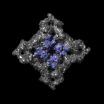(Press-News.org) Quebec City, November 4, 2010—A team of Université Laval and Danisco researchers has just unlocked the secret of bacteria's immune system. The details of the discovery, which may eventually make it possible to prevent certain bacteria from developing resistance to antibiotics, are presented in today's issue of the scientific journal Nature.
The team led by Professor Sylvain Moineau of Université Laval's Department of Biochemistry, Microbiology, and Bioinformatics showed that this mechanism, called CRISPR/Cas, works by selecting foreign DNA segments and inserting them into very specific locations in a bacterium's genome. These segments then serve as a kind of immune factor in fighting off future invasions by cleaving incoming DNA.
The researchers demonstrated this mechanism using plasmids, DNA molecules that are regularly exchanged by bacteria. The plasmid used in the experiment, which contained a gene for antibiotic resistance, was inserted into bacteria used in making yogurt, Streptococcus thermophilus. Some of the bacteria integrated the segments of DNA from the resistance gene into their genome, and subsequent attempts to reinsert the plasmid into these bacteria failed. "These bacteria had simply been immunized against acquiring the resistance gene, commented Professor Moineau. This phenomenon could explain, among other things, why some bacteria develop antibiotic resistance while others don't."
The CRISPR/Cas immune system also protects bacteria from bacteriophages, a group of viruses that specifically target bacteria. This makes Professor Moineau's discovery particularly interesting for food and biotechnology sectors that use bacterial cultures, such as the yogurt, cheese, and probiotics industries. Bacterial culture contamination by bacteriophages is a serious concern with considerable financial implications for those industries.
INFORMATION:
In addition to Sylvain Moineau, this study was coauthored by: Josiane Garneau, Marie-Ève Dupuis, Manuela Villion, and Alfonso H. Magadán from Université Laval; Dennis A. Romero, Rodolphe Barrangou, Patrick Boyaval, Christophe Fremaux, and Philippe Horvath from Danisco.
Information:
Sylvain Moineau
Department of Biochemistry, Microbiology, and Bioinformatics
Université Laval
418-656-3712
Sylvain.Moineau@bcm.ulaval.ca
Researchers unlock the secret of bacteria's immune system
2010-11-05
ELSE PRESS RELEASES FROM THIS DATE:
A 'brand' new world: Attachment runs thicker than money
2010-11-05
Can you forge an emotional bond with a brand so strong that, if forced to buy a competitor's product, you suffer separation anxiety? According to a new study from the USC Marshall School of Business, the answer is yes. In fact, that bond can be strong enough that consumers are willing to sacrifice time, money, energy and reputation to maintain their attachment to that brand.
"Brand Attachment and Brand Attitude Strength: Conceptual and Empirical Differentiation of Two Critical Brand Equity Drivers," a study published in the November issue of the Journal of Marketing, ...
X-rays offer first detailed look at hotspots for calcium-related disease
2010-11-05
Menlo Park, Calif.—Calcium regulates many critical processes within the body, including muscle contraction, the heartbeat, and the release of hormones. But too much calcium can be a bad thing. In excess, it can lead to a host of diseases, such as severe muscle weakness, a fatal reaction to anesthesia or sudden cardiac death.
Now, using intense X-rays from the Stanford Synchrotron Radiation Lightsource (SSRL) at the Department of Energy's SLAC National Accelerator Laboratory, researchers have determined the detailed structure of a key part of the ryanodine receptor, a ...
Colonic navigation
2010-11-05
Nanoparticles could help smuggle drugs into the gut, according to a study published this month in the International Journal of Nanotechnology.
There are several drugs that would have more beneficial therapeutic effects if they could be targeted at absorption by the lower intestine. However, in order to target the colon for treating colon cancer for instance, medication delivered by mouth must surmount several barriers including stomach acidity, binding to mucus layers, rapid clearance from the gut, and premature uptake by cells higher up the gastrointestinal tract. Being ...
Helical CT scans reduce lung cancer mortality by 20 percent compared to chest X-rays
2010-11-05
PROVIDENCE, R.I. [Brown University] — In a major new study announced today by the National Cancer Institute, researchers including Brown University biostatistian Constantine Gatsonis and his colleagues found that screening for lung cancer using helical CT scanning reduced lung cancer deaths by 20 percent compared to using chest X-rays.
"The findings we're announcing today offer the first definitive evidence for the effectiveness of helical CT screening smokers for lung cancer " said Gatsonis, a lead biostatistician in the study and director of the American College of ...
Motor Neurone Disease Association study identifies MND biomarker
2010-11-05
A study funded by the Motor Neurone Disease (MND) Association, in collaboration with the Medical Research Council (MRC), has identified a common signature of nerve damage in the brains of MND patients.
The study's exciting findings have been published in the prestigious journal Neurology (2 November 2010). These are the first results to be published from the ongoing Oxford Study for Biomarkers in MND/ALS (BioMOx).
MND research is being held back by the lack of an early diagnostic test and predictable markers of the progression of the disease – biomarkers. Patients ...
The mind uses syntax to interpret actions
2010-11-05
Most people are familiar with the concept that sentences have syntax. A verb, a subject, and an object come together in predictable patterns. But actions have syntax, too; when we watch someone else do something, we assemble their actions to mean something, according to a new study published in Psychological Science, a journal of the Association for Psychological Science.
"There are oceans and oceans of work on how we understand languages and how we interpret the things other people say," says Matthew Botvinick of Princeton University, who cowrote the paper with his ...
AGU Journal highlights -- Nov. 4, 2010
2010-11-05
The following highlights summarize research papers that have been recently published in Geophysical Research Letters (GRL), Journal of Geophysical Research - Atmospheres (JGR-D), and Journal of Geophysical Research - Earth Surface (JGR-F).
1. Exploring climate patterns linking stratosphere, lower atmosphere
Roughly every 28 months, the zonal winds in the stratosphere at the equator cycle from easterly to westerly and then back to easterly. Known to atmospheric scientists as the quasi-biennial oscillation (QBO), these shifting wind patterns result when the energy from ...
Discovery shows promise against severe side effects
2010-11-05
November 4, 2010 – (BRONX, NY) -- A team of scientists has found a way to eliminate a debilitating side effect associated with one of the main chemotherapy drugs used for treating colon cancer. The strategy used in their preclinical research—inhibiting an enzyme in bacteria of the digestive tract—could allow patients to receive higher and more effective doses of the drug, known as CPT-11 or Irinotecan.
The study, spearheaded by scientists at the University of North Carolina at Chapel Hill and involving collaborators at Albert Einstein College of Medicine of Yeshiva University ...
Volcanic eruptions affect rainfall over Asian monsoon region
2010-11-05
Scientists have long known that large volcanic explosions can affect the weather by spewing particles that block solar energy and cool the air.
Some suspect that extended "volcanic winters" from gigantic eruptions helped kill off dinosaurs and Neanderthals.
In the summer following Indonesia's 1815 Tambora eruption, frost wrecked crops as far away as New England, and the 1991 blowout of the Philippines' Mount Pinatubo lowered average global temperatures by 0.7 degrees F--enough to mask the effects of greenhouse gases for a year or so.
Now, in research funded by the ...
UC doctoral student presents research at international conference
2010-11-05
Clement Loo, a University of Cincinnati doctoral student in the philosophy program, was one of the featured researchers at the biennial meeting of the Philosophy of Science Association Nov. 4-6 in Montreal, Quebec. The association promotes research, teaching and free discussion of issues in the philosophy of science.
Loo presented research themed around a Nov. 4 session on biology, evolution and selection. His paper was titled, "Invasive Species and Evaluating the Relative Significance of the Shifting Balance Theory."
The paper focused on the R.A. Fisher and Sewall ...

